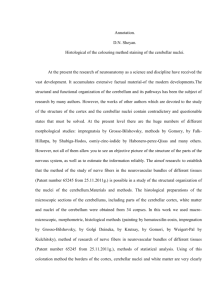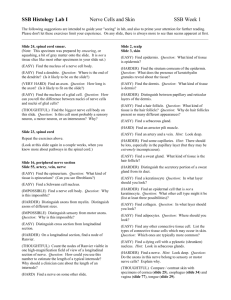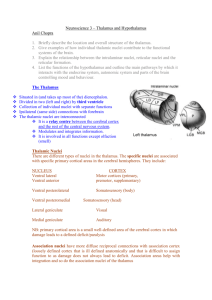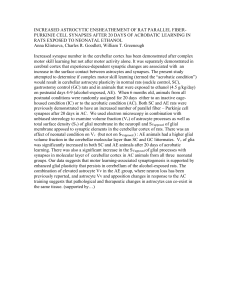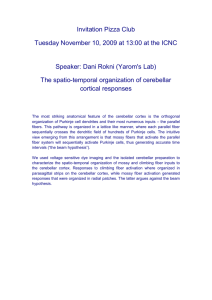Histology Lab I
advertisement
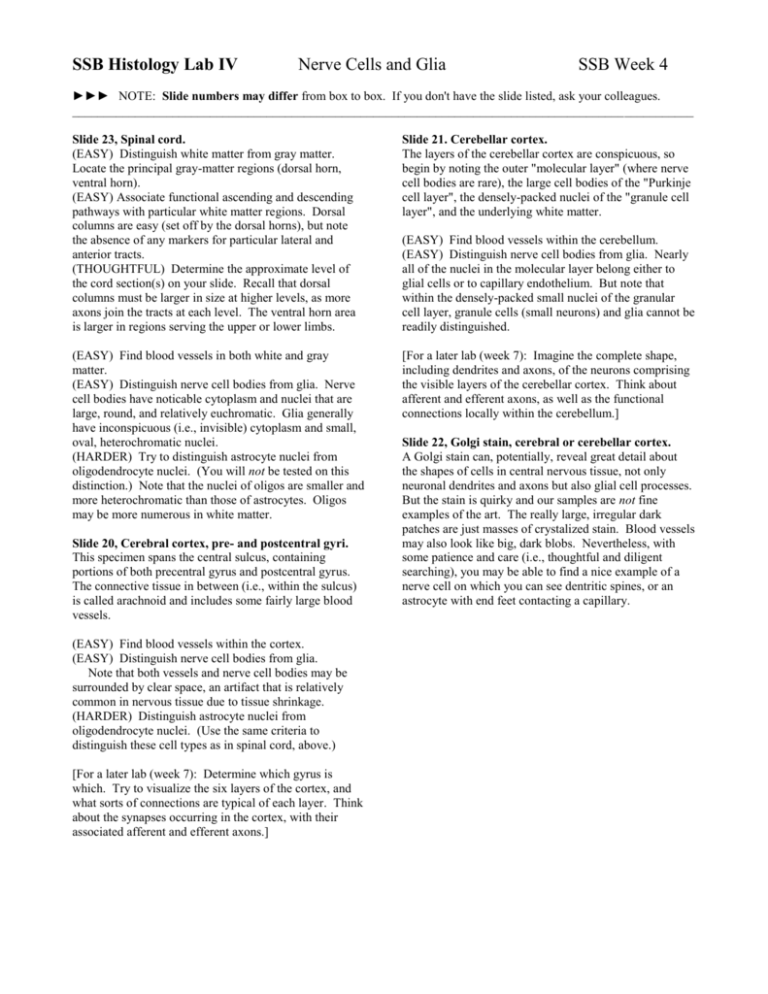
SSB Histology Lab IV Nerve Cells and Glia SSB Week 4 ►►► NOTE: Slide numbers may differ from box to box. If you don't have the slide listed, ask your colleagues. ___________________________________________________________________________________________________ Slide 23, Spinal cord. (EASY) Distinguish white matter from gray matter. Locate the principal gray-matter regions (dorsal horn, ventral horn). (EASY) Associate functional ascending and descending pathways with particular white matter regions. Dorsal columns are easy (set off by the dorsal horns), but note the absence of any markers for particular lateral and anterior tracts. (THOUGHTFUL) Determine the approximate level of the cord section(s) on your slide. Recall that dorsal columns must be larger in size at higher levels, as more axons join the tracts at each level. The ventral horn area is larger in regions serving the upper or lower limbs. Slide 21. Cerebellar cortex. The layers of the cerebellar cortex are conspicuous, so begin by noting the outer "molecular layer" (where nerve cell bodies are rare), the large cell bodies of the "Purkinje cell layer", the densely-packed nuclei of the "granule cell layer", and the underlying white matter. (EASY) Find blood vessels in both white and gray matter. (EASY) Distinguish nerve cell bodies from glia. Nerve cell bodies have noticable cytoplasm and nuclei that are large, round, and relatively euchromatic. Glia generally have inconspicuous (i.e., invisible) cytoplasm and small, oval, heterochromatic nuclei. (HARDER) Try to distinguish astrocyte nuclei from oligodendrocyte nuclei. (You will not be tested on this distinction.) Note that the nuclei of oligos are smaller and more heterochromatic than those of astrocytes. Oligos may be more numerous in white matter. [For a later lab (week 7): Imagine the complete shape, including dendrites and axons, of the neurons comprising the visible layers of the cerebellar cortex. Think about afferent and efferent axons, as well as the functional connections locally within the cerebellum.] Slide 20, Cerebral cortex, pre- and postcentral gyri. This specimen spans the central sulcus, containing portions of both precentral gyrus and postcentral gyrus. The connective tissue in between (i.e., within the sulcus) is called arachnoid and includes some fairly large blood vessels. (EASY) Find blood vessels within the cortex. (EASY) Distinguish nerve cell bodies from glia. Note that both vessels and nerve cell bodies may be surrounded by clear space, an artifact that is relatively common in nervous tissue due to tissue shrinkage. (HARDER) Distinguish astrocyte nuclei from oligodendrocyte nuclei. (Use the same criteria to distinguish these cell types as in spinal cord, above.) [For a later lab (week 7): Determine which gyrus is which. Try to visualize the six layers of the cortex, and what sorts of connections are typical of each layer. Think about the synapses occurring in the cortex, with their associated afferent and efferent axons.] (EASY) Find blood vessels within the cerebellum. (EASY) Distinguish nerve cell bodies from glia. Nearly all of the nuclei in the molecular layer belong either to glial cells or to capillary endothelium. But note that within the densely-packed small nuclei of the granular cell layer, granule cells (small neurons) and glia cannot be readily distinguished. Slide 22, Golgi stain, cerebral or cerebellar cortex. A Golgi stain can, potentially, reveal great detail about the shapes of cells in central nervous tissue, not only neuronal dendrites and axons but also glial cell processes. But the stain is quirky and our samples are not fine examples of the art. The really large, irregular dark patches are just masses of crystalized stain. Blood vessels may also look like big, dark blobs. Nevertheless, with some patience and care (i.e., thoughtful and diligent searching), you may be able to find a nice example of a nerve cell on which you can see dentritic spines, or an astrocyte with end feet contacting a capillary.
